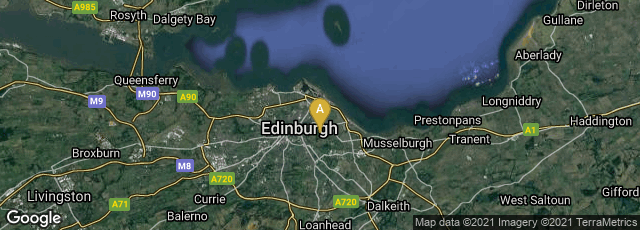

A: Edinburgh, Scotland, United Kingdom
From December 1768 to 1771 "A Society of Gentlemen in Scotland" based in Edinburgh published, in 100 fascicules issued weekly, the Encyclopaedia Britannica; or a Dictionary of Arts and Sciences Compiled upon a New Plan in which the different Sciences and Arts and digest into distinct Treatsies or Systems; and the various Technical Terms etc. are explained as they occur in the order of the Alphabets. Illustrated with One Hundred and Sixty Copperplates.
The complete first edition issued in 1771 was bound in three volumes. The Edinburgh 'society' mentioned on the title page may have consisted only of the editor, the printer, antiquarian, and encyclopedist William Smellie, the engraver, Andrew Bell, and the printer, Colin Macfarquhar.
"It was a masterful composition although, by his own admission, Smellie borrowed liberally from many authors of his day, such as Voltaire, Benjamin Franklin, Alexander Pope and Samuel Johnson. Nevertheless, the first edition of the Britannica contained gross inaccuracies and fanciful speculations; for example, it states that excess use of tobacco could cause neurodegeneration, 'drying up the brain to a little black lump consisting of mere membranes'. Smellie strove to make Britannica as usable as possible, saying that 'utility ought to be the principal intention of every publication. Wherever this intention does not plainly appear, neither the books nor their authors have the smallest claim to the approbation of mankind'. Smellie entertained strong opinions; for example, he defines farriery as 'the art of curing the diseases of horses. The practice of this useful art has been hitherto almost entirely confined to a set of men who are totally ignorant of anatomy, and the general principles of medicine.' Although possessed of wide knowledge, Smellie was not an e'pert in all matters; for example, his article on 'Woman' has but four words: "the female of man.' Despite its incompleteness and inaccuracies, Smellie's vivid prose and the easy navigation of the first edition led to strong demand for a second; some prurient engravings by Andrew Bell (later censored by King George III) may also have contributed to the success of the first edition. Smellie did not participate in the second edition of the Britannica, because he objected to the inclusion of biographical articles in an encyclopedia dedicated to the arts and sciences." (Wikipedia article on William Smellie, accessed 12-04-2008).
". . .the eleventh edition, 1910-11, is noteworthy for its index which has justly been described as the best index of any work of reference"(Carter & Muir, Printing and the Mind of Man [1967] no. 218.)